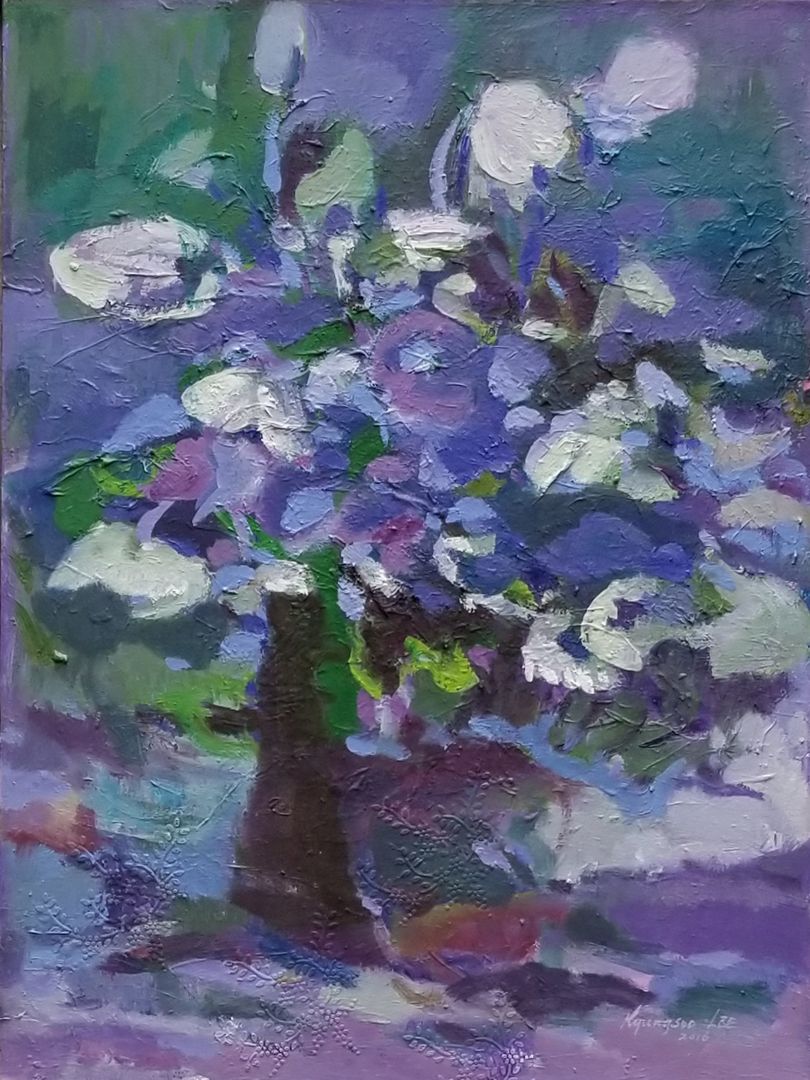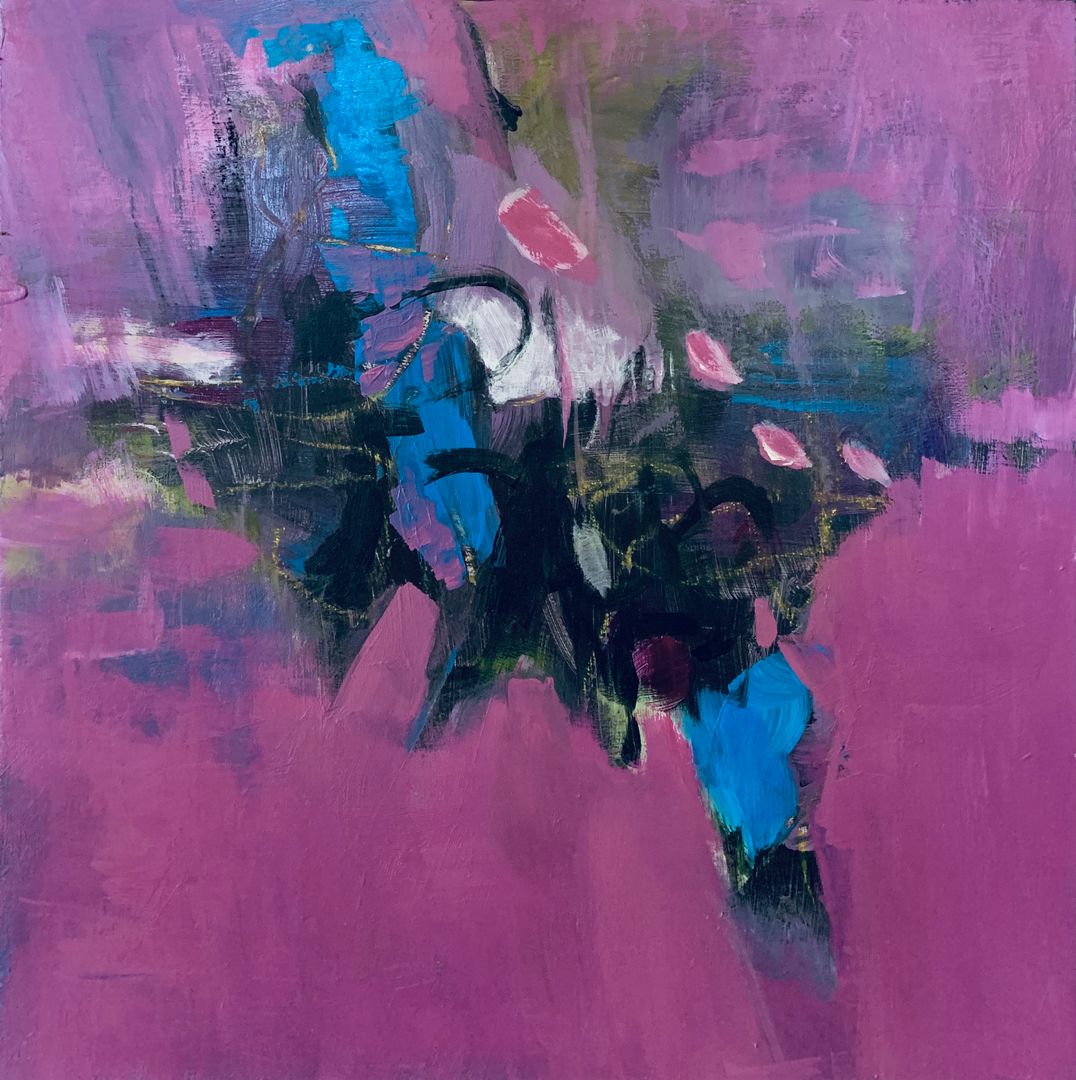Moon Dance
This original painting is on canvas(24x18) with oil paint. Artist Lee approaches her canvas with little or no preconceived notion of what will occur. She has a disciplined ability to quiet the verbal, analytical part of her mind and allow that silent creative half of the brain to dominate. Her painting is a process of discovery, evolving from the repetition of gestures and the layering of color over color. Her perceptive color sense lends strength to the delicate line and soft tones of her imaginary natural abstractions. The painting is ready to hang with a frame and the total size is 25.5h x 19.5w x 2d inches.
Responses (1)

November 11, 2021
A first impression of Kyungsoo Lee’s Moon Dance is a field of vivid purple. It’s arresting, and the contrast between colors in the painting immediately draws the eye. Wait a moment, though, and the colors start to sort themselves out--the purples dissolve into muted shades, of lavender and periwinkle, twilight blue and rich mauves. The moon of the title isn't itself apparent--but its presence is. As you look, the colors start to form shapes and patterns--a tree, perhaps, dappled with blossoms in the moonlight, or a vase of flowers on a bright night--perhaps the moon shining in through a window. The moon's light is apparent through the extra bright white of the cream and white splotches that are scattered throughout, as if moonlight was shining directly on them.
Keep looking, and other shades appear--forest and pale greens and rich earth brown, as well a reddish brown imbued with lighter tones. The repetition of colors ties the painting together and unifies it; that repetition also keeps the eye moving, looking for connections.
Shapes too are repeated—half-moons and elongated ovals; donuts with contrasting colors in the middle, like holiday treats run amok. The repetition of both shape and color gives the painting a coherence and a sense of unity.
Another impression is of, well, Impressionism--flashes of works by Renoir and Monet going through your mind are inevitable. It’s hard not think of a close-up of Monet’s Water Lilies, for instance, with its flowers shimmering on the water; similar shades of blue and cream; and a similar feel, as if it were a distant third cousin, perhaps. It’s easy to visualize the background of Lee’s painting as water, with petals floating or perhaps a reflected tree. Monet’s The Artist’s Garden at Giverny also springs to mind—Monet’s painting shows a rich, lush tapestry of flowers and a canopy of thin-trunked trees.
Renoir’s The Skiff shows two women in a boat, one of them holding an oar. The dappled multicolored water evokes a similar feel to Lee’s painting as well. The layering of colors and deliberately obvious brushstrokes in her work are also similar to Impressionist works of art, producing the textural, jewel-toned glow that permeates these paintings.
Abstraction is also at work here. Look and let your mind wander; rather than seeing forms in nature, you might see shapes in and of themselves, separate from any specific object or place. The painting resolves itself into gently curving bursts of color, rough-edged dabs of light and dark, few hard lines. It takes on a dreamy, underwater feel; you’ll notice textures that resemble tiny leaves and vines, as if they’ve been embossed onto the background. Keep looking, and more shapes emerge, whether from the painting or your imagination, it’s hard to say. There’s…a leaf? A badger? A Tribble? (Maybe not.) Is it in a large garden? On a pebbled path near the sea? If this is a moon-drenched view, what would it look like in the daytime? One wonders what the painting might have looked like with a softening of the palette and an even further blurring of some of the edges, to convey the strangeness of even familiar scenes under the moon.
There’s even a faint resemblance to Japanese landscape painting—while this work doesn’t have the starkness or the muted colors of those works, there’s something about the white blossoms and the seeming aloneness of the tree that brings to mind the comparison.
Edward Hopper famously stated, “If I could say it in words, there would be no reason to paint.” That sentiment has been echoed in various ways by scores of other artists as well, and it’s a also reflection of how even laypeople feel when struck with a scene, or a memory, or an emotion for which we literally do not have words: Paintings can say it for us, bring up remembered places and times.
Those trees, in fact, are part of a long lineage of trees in art and story, from Greek myths where oracles held forth in groves of trees, to the whistling though an oak grove symbolizing the voice of Zeus; to, well the Ents (giant walking trees) in Lord of the Rings. This painting brings up a tangle of memories and works of art and literature, from groves of fruit trees to the tree of life; the claw-branched forests in fairy tales and the Weirwood Tree in Game of Thrones.
Not just a connection with nature, but a connection with the natural world as permanence, linking the Japanese landscape, Renoir’s spindly branches, Monet’s glorious blossoms, and Lee’s Moon Dance.

- Category
- Nature, Fauvism
- Type
- Painting - Framed
- Materials
- Oil
- Dimensions
-
19.50 inches wide
25.50 inches tall
2.00 inches deep - Weight
- 5.00 lbs
- Location
- Murrieta, CA, US







